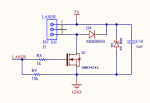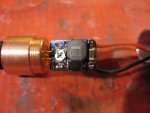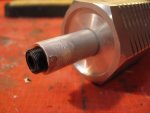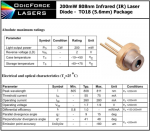I am using a laser diode in a device and I am trying to figure out what needs to happen for it to interface with the rest of the electronics. It is a 1W laser diode and the diode will be turned on for 1ms pulses, each pulse going off once every couple minutes. Do I need to worry about a heat sink or can I just solder the diode right to a PCB?

Welcome to Laser Pointer Forums - discuss green laser pointers, blue laser pointers, and all types of lasers
How to Register on LPF | LPF Donations
Navigation
Install the app
How to install the app on iOS
Follow along with the video below to see how to install our site as a web app on your home screen.
Note: This feature may not be available in some browsers.
More options

You are using an out of date browser. It may not display this or other websites correctly.
You should upgrade or use an alternative browser.
You should upgrade or use an alternative browser.
Can I solder a laser diode directly to a PCB?
- Thread starter Chuie
- Start date


Are you meaning mounting a diode on a driver pcb or just soldering a bare laser diode leads w/o module or heatsink to a laser diode driver PCB terminals?
Here is a link about pulsed laser diodes --- https://www.laserdiodecontrol.com/How-to-Choose-a-Pulsed-Laser-Diode-Driver
Here is a link about pulsed laser diodes --- https://www.laserdiodecontrol.com/How-to-Choose-a-Pulsed-Laser-Diode-Driver
Last edited:
- Joined
- Sep 12, 2007
- Messages
- 9,399
- Points
- 113
Soldering directly to a PCB is how many drivers are typically interfaced.
Running a high power laser diode without a heat sink typically results in death within seconds. However, since your duty cycle is waaaay down in the ppm area, it's perfectly safe to do. The main drawback is a difficulty in aligning any collimation optics you may require.
What exactly are you trying to do?
Running a high power laser diode without a heat sink typically results in death within seconds. However, since your duty cycle is waaaay down in the ppm area, it's perfectly safe to do. The main drawback is a difficulty in aligning any collimation optics you may require.
What exactly are you trying to do?
- Joined
- Sep 12, 2007
- Messages
- 9,399
- Points
- 113
it may get fried before you even get to turn it on.

I'm going to assume you mean the soldering temperature. To this I say: read a few sample datasheets. It's not an issue.
- Joined
- Sep 12, 2007
- Messages
- 9,399
- Points
- 113
Fun side thing. Fair enough.
The problem here as I see it is you're shoving a raw 5V into the diode with no current limiting. 1ms or not, this will likely pop it unless you accidentally manage enough parasitic impedance in your construction. At the very least you're going to need a dropper resistor in series.
The problem here as I see it is you're shoving a raw 5V into the diode with no current limiting. 1ms or not, this will likely pop it unless you accidentally manage enough parasitic impedance in your construction. At the very least you're going to need a dropper resistor in series.
- Joined
- Dec 15, 2014
- Messages
- 6,773
- Points
- 113
To this I say: read a few sample datasheets. It's not an issue.
Soldering temperatures can range from anywhere between 626°F-662°F (330°C-350°C) and the melting region of most solder is 370°F (188°C). Below is a sample data I from OdicForce, and it says for the absolute maximum ratings it has a case temperature of max 50°C and a storage temperature of 75°C. Sure enough, if you leave that iron on the diode for some time, it will eventually kill the diode. This is especially without a heat sink. I've also remembered killing one of my diodes due to excessive heat, not from the driver.
Attachments
- Joined
- Sep 12, 2007
- Messages
- 9,399
- Points
- 113
Like it was said no heat sink say by by to the diode poof!!!
Please read the thread before commenting.
1ms every 120 seconds is an average of ~50 microwatts of heat. A bare diode will have no difficulty with that.
for the absolute maximum ratings it has a case temperature of max 50°C and a storage temperature of 75°C. Sure enough, if you leave that iron on the diode for some time, it will eventually kill the diode.
Storage temperature and soldering temperature are VASTLY different parameters, sir.
Here. Here's an example. 1.6W blue from osram. Storage of 85C, but soldering temperature of 260C. :
"BuT CyP", I hear you complain, "mY sOlDeRiNg IrOn iS aT 360C!!2?!"
60/40 lead solder melts at 188C. Lead free solder is only 220. You don't need a 360C iron to melt that. Even if you did, it'd be fine. Really.
Pretty f
- Joined
- Dec 15, 2014
- Messages
- 6,773
- Points
- 113
Hi,
That copper collar around the diode isn't enough sinking .you need to press the diode into a 12mm module for a 5.6mm diode..After you set the driver to a specific setting for that diode and wired you add thermal compound and slide it into one of these heat sinks for the diode to last. your data sheet tells you what you need to follow
Rich
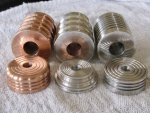
That copper collar around the diode isn't enough sinking .you need to press the diode into a 12mm module for a 5.6mm diode..After you set the driver to a specific setting for that diode and wired you add thermal compound and slide it into one of these heat sinks for the diode to last. your data sheet tells you what you need to follow
Rich

Bruh, if you want to get technical take a look at the specific heat capacity of lead solder. The multiply that by the 1g tops of solder you'll be dabbing onto it and the temperature it's at. Then multiply the specific heat capacity of the primary construction metal of the diode by its weight and then multiply by its peak storage temperature. Divide the value you just calculated by the first value you calculated, if it is above 1 then solder cannot possibly heat damage the diode.With all due respect, diodes can be expensive so yea obviously I would give a **** to account for any possible failure. For the record, I don't run my diode "300% overcurrent." Please don't exaggerate. Soldering while it's in its housing is not a problem I thought the user was referring to just soldering directly to the diode without housing or anything at first, as the housing acts as a heat absorber.
I'm not going to do the math for you
Bruh, if you want to get technical take a look at the specific heat capacity of lead solder. The multiply that by the 1g tops of solder you'll be dabbing onto it and the temperature it's at. Then multiply the specific heat capacity of the primary construction metal of the diode by its weight and then multiply by its peak storage temperature. Divide the value you just calculated by the first value you calculated, if it is above 1 then solder cannot possibly heat damage the diode.
I'm not going to do the math for you
If you really think soldering is all I'm concerned about don't forget a static shock can also kill your diode faster than that
That be true indeed. On that note, is it possible to discharge static by using your water mains?If you really think soldering is all I'm concerned about don't forget a static shock can also kill your diode faster than that
- Joined
- Sep 12, 2007
- Messages
- 9,399
- Points
- 113
...take a look at the specific heat capacity of lead solder...
Yes, you need a tip temperature above the 188C to melt solder. But if you can't solder something as small as a diode pin at 260C, you're either really bad at soldering, or your iron is shite.


